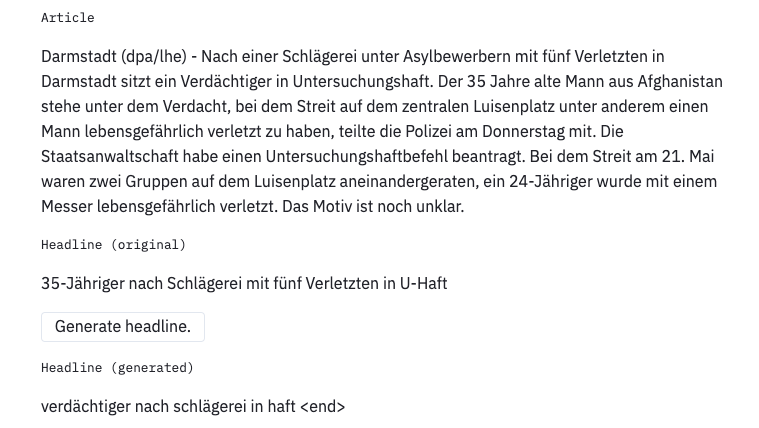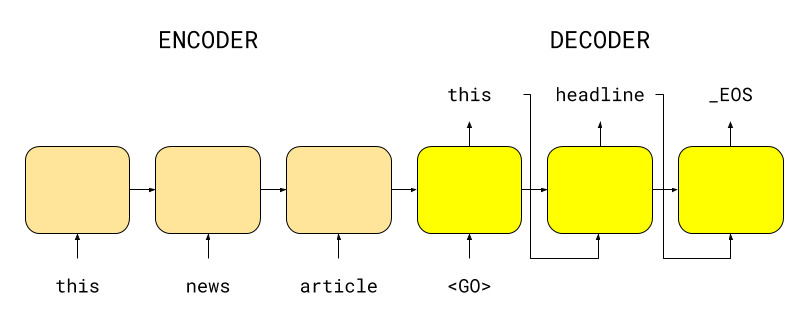Headliner is a sequence modeling library that eases the training and in particular, the deployment of custom sequence models for both researchers and developers. You can very easily deploy your models in a few lines of code. It was originally built for our own research to generate headlines from Welt news articles (see figure 1). That's why we chose the name, Headliner.
Figure 1: One example from our Welt.de headline generator.
We use sequence-to-sequence (seq2seq) under the hood, an encoder-decoder framework (see figure 2). We provide a very simple interface to train and deploy seq2seq models. Although this library was created internally to generate headlines, you can also use it for other tasks like machine translations, text summarization and many more.
Figure 2: Encoder-decoder sequence-to-sequence model.
You may ask why another seq2seq library? There are a couple of them out there already. For example, Facebook has fairseq, Google has seq2seq and there is also OpenNMT. Although those libraries are great, they have a few drawbacks for our use case e.g. the former doesn't focus much on production whereas the Google one is not actively maintained. OpenNMT was the closest one to match our requirements i.e. it has a strong focus on production. However, we didn't like that their workflow (preparing data, training and evaluation) is mainly done via the command line. They also expose a well-defined API though but the complexity there is still too high with too much custom code (see their minimal transformer training example).
Therefore, we built this library for us with the following goals in mind:
- Easy-to-use API for training and deployment (only a few lines of code)
- Uses TensorFlow 2.0 with all its new features (
tf.function,tf.keras.layersetc.) - Modular classes: text preprocessing, modeling, evaluation
- Extensible for different encoder-decoder models
- Works on large text data
For more details on the library, read the documentation at: https://as-ideas.github.io/headliner/
Headliner is compatible with Python 3.6 and is distributed under the MIT license.
⚠️ Before installing Headliner, you need to install TensorFlow as we use this as our deep learning framework. For more details on how to install it, have a look at the TensorFlow installation instructions.
Then you can install Headliner itself. There are two ways to install Headliner:
- Install Headliner from PyPI (recommended):
pip install headliner- Install Headliner from the GitHub source:
git clone https://github.com/as-ideas/headliner.git
cd headliner
python setup.py installFor the training, you need to import one of our provided models or create your own custom one. Then you need to
create the dataset, a tuple of input-output sequences, and then train it:
from headliner.trainer import Trainer
from headliner.model.summarizer_transformer import SummarizerTransformer
data = [('You are the stars, earth and sky for me!', 'I love you.'),
('You are great, but I have other plans.', 'I like you.')]
summarizer = SummarizerTransformer(embedding_size=64, max_prediction_len=20)
trainer = Trainer(batch_size=2, steps_per_epoch=100)
trainer.train(summarizer, data, num_epochs=2)
summarizer.save('/tmp/summarizer')The prediction can be done in a few lines of code:
from headliner.model.summarizer_transformer import SummarizerTransformer
summarizer = SummarizerTransformer.load('/tmp/summarizer')
summarizer.predict('You are the stars, earth and sky for me!')Currently available models include a basic encoder-decoder, an encoder-decoder with Luong attention and the transformer:
from headliner.model.summarizer_basic import SummarizerBasic
from headliner.model.summarizer_attention import SummarizerAttention
from headliner.model.summarizer_transformer import SummarizerTransformer
summarizer_basic = SummarizerBasic()
summarizer_attention = SummarizerAttention()
summarizer_transformer = SummarizerTransformer()Training using a validation split and model checkpointing:
from headliner.model.summarizer_transformer import SummarizerTransformer
from headliner.trainer import Trainer
train_data = [('You are the stars, earth and sky for me!', 'I love you.'),
('You are great, but I have other plans.', 'I like you.')]
val_data = [('You are great, but I have other plans.', 'I like you.')]
summarizer = SummarizerTransformer(num_heads=1,
feed_forward_dim=512,
num_layers=1,
embedding_size=64,
max_prediction_len=50)
trainer = Trainer(batch_size=8,
steps_per_epoch=50,
max_vocab_size_encoder=10000,
max_vocab_size_decoder=10000,
tensorboard_dir='/tmp/tensorboard',
model_save_path='/tmp/summarizer')
trainer.train(summarizer, train_data, val_data=val_data, num_epochs=3)Prediction information such as attention weights and logits can be accessed via predict_vectors returning a dictionary:
from headliner.model.summarizer_transformer import SummarizerTransformer
summarizer = SummarizerTransformer.load('/tmp/summarizer')
summarizer.predict_vectors('You are the stars, earth and sky for me!')A previously trained summarizer can be loaded and then retrained. In this case the data preprocessing and vectorization is loaded from the model.
train_data = [('Some new training data.', 'New data.')] * 10
summarizer_loaded = SummarizerTransformer.load('/tmp/summarizer')
trainer = Trainer(batch_size=2)
trainer.train(summarizer, train_data)
summarizer_loaded.save('/tmp/summarizer_retrained')Embeddings in GloVe format can be injected in to the trainer as follows. Optionally, set the embedding to non-trainable.
trainer = Trainer(embedding_path_encoder='/tmp/embedding_encoder.txt',
embedding_path_decoder='/tmp/embedding_decoder.txt')
# make sure the embedding size matches to the embedding size of the files
summarizer = SummarizerTransformer(embedding_size=64,
embedding_encoder_trainable=False,
embedding_decoder_trainable=False)A model can be initialized with custom preprocessing and tokenization:
from headliner.preprocessing import Preprocessor
train_data = [('Some inputs.', 'Some outputs.')] * 10
preprocessor = Preprocessor(filter_pattern='',
lower_case=True,
hash_numbers=False)
train_prep = [preprocessor(t) for t in train_data]
inputs_prep = [t[0] for t in train_prep]
targets_prep = [t[1] for t in train_prep]
# Build tf subword tokenizers. Other custom tokenizers can be implemented
# by subclassing headliner.preprocessing.Tokenizer
from tensorflow_datasets.core.features.text import SubwordTextEncoder
tokenizer_input = SubwordTextEncoder.build_from_corpus(
inputs_prep, target_vocab_size=2**13)
tokenizer_target = SubwordTextEncoder.build_from_corpus(
targets_prep, target_vocab_size=2**13)
vectorizer = Vectorizer(tokenizer_input, tokenizer_target)
summarizer = SummarizerTransformer(embedding_size=64, max_prediction_len=50)
summarizer.init_model(preprocessor, vectorizer)
trainer = Trainer(batch_size=2)
trainer.train(summarizer, train_data, num_epochs=3)Large datasets can be handled by using an iterator:
def read_data_iteratively():
return (('Some inputs.', 'Some outputs.') for _ in range(1000))
class DataIterator:
def __iter__(self):
return read_data_iteratively()
data_iter = DataIterator()
summarizer = SummarizerTransformer(embedding_size=10, max_prediction_len=20)
trainer = Trainer(batch_size=16, steps_per_epoch=1000)
trainer.train(summarizer, data_iter, num_epochs=3)We welcome all kinds of contributions such as new models, new examples and many more. See the Contribution guide for more details.
Please cite Headliner in your publications if this is useful for your research. Here is an example BibTeX entry:
@misc{axelspringerai2019headliners,
title={Headliner},
author={Christian Schäfer & Dat Tran},
year={2019},
howpublished={\url{https://github.com/as-ideas/headliner}},
}- Christian Schäfer, github: cschaefer26
- Dat Tran, github: datitran
See LICENSE for details.




